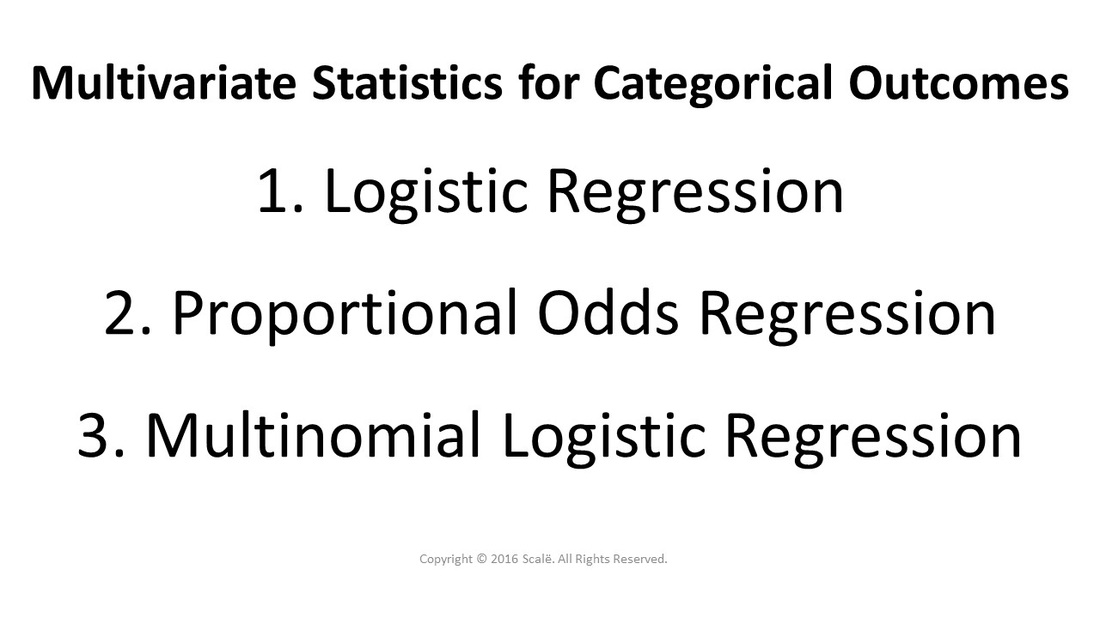Multivariate statistics for categorical outcomes
Choice of multivariate statistical test depends upon the type of categorical outcome
Multivariate statistics for categorical and ordinal outcomes are different from traditional multiple regression models. The primary inferences yielded from multivariate statistics for categorical outcomes are adjusted odds ratios with 95% confidence intervals. However, multivariate statistics with categorical outcomes have similar statistical assumptions with multivariate statistics with continuous outcomes. It is important to remember that many more observations of the outcome will be needed when predicting for categorical and ordinal outcomes. This is due to limited precision and accuracy in measurement of outcomes at categorical and ordinal levels.
Survival or time-to-event analysis falls under the guise of multivariate statistics with categorical outcomes. These types of statistics are used to understand the temporal differences among independent groups in terms of developing an outcome or disease state. When conducting survival statistics, researchers need a primary predictor variable denoting group membership, a dichotomous categorical outcome variable with one level defined as the "event," and some sort of time signature associated with developing the outcome. The time increment of the temporal differences can be in seconds, minutes, hours, days, weeks, months, or even years, depending upon the etiology and prognosis of the event or disease state of interest.
Choosing the correct multivariate statistical test for a categorical outcome or ordinal outcome depends upon the number of levels of the variable that are being measured.
Survival or time-to-event analysis falls under the guise of multivariate statistics with categorical outcomes. These types of statistics are used to understand the temporal differences among independent groups in terms of developing an outcome or disease state. When conducting survival statistics, researchers need a primary predictor variable denoting group membership, a dichotomous categorical outcome variable with one level defined as the "event," and some sort of time signature associated with developing the outcome. The time increment of the temporal differences can be in seconds, minutes, hours, days, weeks, months, or even years, depending upon the etiology and prognosis of the event or disease state of interest.
Choosing the correct multivariate statistical test for a categorical outcome or ordinal outcome depends upon the number of levels of the variable that are being measured.
What type of categorical outcome is being used for multivariate statistics?
Researchers are comparing independent groups on a dichotomous categorical outcome event, across different treatment or environmental conditions.
There are only two mutually exclusive and independent levels of the categorical outcome variable. It is a dichotomous outcome.
There are three or more mutually exclusive and independent levels of the categorical outcome variable. It is a polychotomous outcome.
Researchers are predicting for an ordinal outcome.
Researchers are comparing independent groups on the time to a dichotomous categorical outcome/event. Kaplan-Meier curve, log-rank test, Cox regression are examples of time-to-event/survival analyses.
Statistician For Hire
DO YOU NEED TO HIRE A STATISTICIAN?
Eric Heidel, Ph.D. will provide statistical consulting for your research study at $100/hour. Secure checkout is available with PayPal, Stripe, Venmo, and Zelle.
- Statistical Analysis
- Sample Size Calculations
- Diagnostic Testing and Epidemiological Calculations
- Psychometrics

